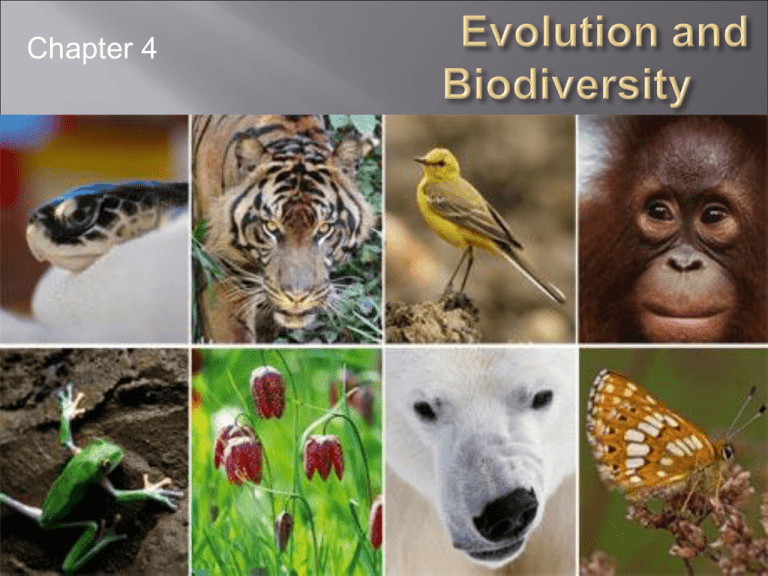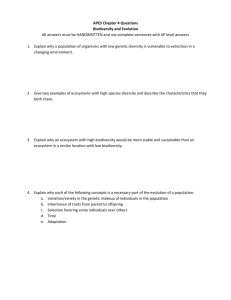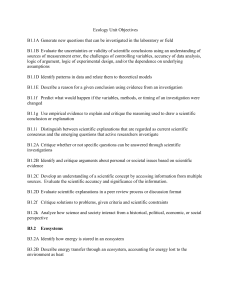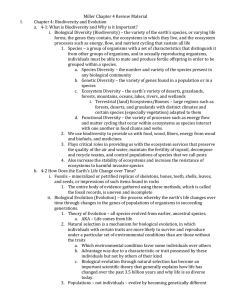species - Lake Stevens High School
advertisement

Chapter 4 Biodiversity: the variety of earth’s species, the genes they contain, the ecosystems in which they live and the ecosystem processes and energy flow that sustain all life • the variety of different species living in a particular area provides us with food, energy, medicine, air and water quality, population control and other “free” ecosystem services estimated 8-100 million species on earth, we have identified about 1.9 million different species most species located in the tropical rain forests. Insects are the most prolific species diversity number of species living in an ecosystem genetic diversity diversity in genes that allows differential survival and reproduction in changing ecosystems (ability to adapt) ecosystem diversity different terrestrial (biomes) and aquatic ecosystems functional diversity processes such as energy and matter cycling through ecosystems (food webs, keystone predators, nutrient cycles etc.) • Biological Evolution by Natural Selection • Charles Darwin in 1859 • evidence from observations (adaptations to environments) and fossil evidence • • struggle for survival gives organisms an advantage to survive and reproduce, allowing them to pass advantageous traits on to the next generation • “survival of the fittest” evolution: process whereby life changes over time through changes in the genetic characteristics of populations in response to environmental pressures. • all species descended from an earlier ancestral species relies on genetic variation within populations occurs via mutations (random changes in DNA sequences) may result from mistakes during DNA replication or protein synthesis or exposure to mutating agents--chemicals (mutagens) only mutations in reproductive cells will be passed on (heritable traits) populations may also experience genetic drift, genetic bottlenecks and the founder effect environmental conditions favor some individuals (traits) over others some individuals have an advantage (adaptation) that allow them to survive and reproduce under specific environmental conditions must lead to differential reproduction (those with the trait have more offspring than those without) Geologic processes tectonic plates drift and move slowly earthquakes and volcanoes (isolate populations, or eliminate entire populations) location of continents and oceans influence climate allow species to move and adapt to new environments, thus allowing speciation to happen Climate change glaciation and warming periods (raising sea levels) affects locations/types of ecosystems a species is a group of individuals in a population that mate and produce fertile offspring speciation is a process where one species splits into two groups and can no longer produce fertile offspring together geographic isolation: physical isolation for a long period of time reproductive isolation: mutations and changes in genetic information result in populations not being able to reproduce successfully with original population (last step in speciation) when an entire species ceases to exist either globally (biological) or in a specific region (local) species must either adapt, move or face extinction during environmental changes mass extinction: large, catastrophic and widespread loss of species (20-25%) in a few million years earth has had 3-5 mass extinctions, some argue we are currently undergoing another mass extinction that is human caused usually followed by a large period of speciation as new species fill available ecological niches balance between speciation and extinction determines earth’s biodiversity Species Diversity • • species richness: number of species present • highest in tropics and decreases as move toward poles (rain forests, coral reefs, tropical lakes, islands and ocean-bottom are highest) • more diverse an ecosystem is the more productive it will be (more producers=more biomass=more consumers supported) • complex ecosystems (high richness) will be better able to withstand disturbances, disease and infestations • more ways to respond to environmental stresses and changes • high net primary productivity ecological niche: role a species plays in a specific ecosystem includes everything that will affect its survival and reproduction generalist species: broad niches (live everywhere, eat anything) specialist species: narrow niche (live in specific habitat, eat specific food, tolerate narrow range of environmental conditions) endemic species: species found only in one area, vulnerable to extinction native species: species that normally thrive in a particular ecosystem non-native (invasive) species: species that migrate or are introduced to an ecosystem kudzu vine and feral pigs in the southwest indicator species: provide early warnings of damage to an ecosystem amphibians sensitive to chemical changes and pollutants keystone species: roles have large effect on types and abundance of other species in an ecosystem. large predatory fish on coral reefs keep other fish populations from exploding foundation species: creating and enhancing their habitats in a way that benefit other species beavers building dams to flood areas and create wetlands • increasing rate of speciation through artificial selection and genetic engineering • habitat destruction and fragmentation • overfishing and poaching • climate change • disruption of ecosystems • introducing invasive species A region of high biodiversity that is under direct threat from humans Targeted areas where protection needs to happen first (lost 70%+) of original habitat High number of endemic species (not found anywhere else in world)








